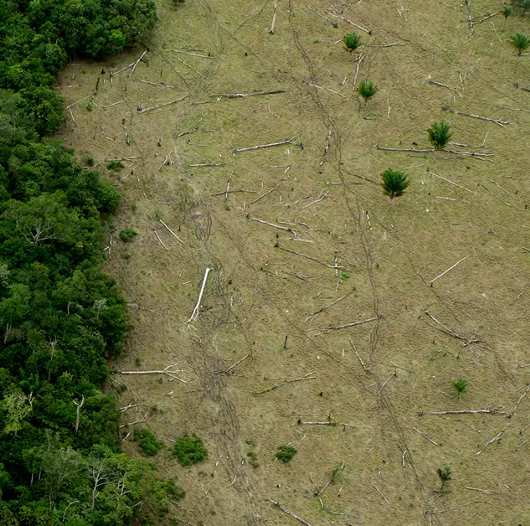Protecting Rainforests with Data and AI: 4 Lessons for the Enterprise


As CEO of Hitachi Vantara, Gajen helps solve clients’ problems by bringing to bear Hitachi’s unrivaled industrial expertise across sectors.
You might not think saving the world’s tropical rainforests is a data challenge, but the urgent task of protecting the last remaining two million square miles of forest is precisely that. What is more, the challenge holds vital lessons for anyone tackling a data project with seemingly insurmountable odds.
Logging, much of it illegal, strips the planet of more than 32 million acres of natural forest every year. If you ever imagined literally trying to find a needle in a haystack, then you might be able to contemplate what it is like to find a chainsaw in forested areas the size of Australia.
Even if you could position a listening device where it could protect every tree, the scale of the rainforests means it would take weeks for preservationists to reach an illegal logging site. One and one-half acres of rainforest are lost every second, so the speed and accuracy of interventions counts.
At the current rate of decline, it is estimated that tropical rainforests could be wiped out as functioning ecosystems in less than 100 years. Maybe your data projects are sounding easy by comparison?
This topic is especially important to me, because for the last two years, we have been working on this challenge with San Francisco-based non-profit Rainforest Connection as part of Hitachi’s Social Innovation strategy. Rainforest Connection builds solar-powered devices called “Guardians” that are installed high on the rainforest canopy to gather acoustic data that could signal when illegal logging is happening, or about to happen.
Our mission was to apply deep learning to review and verify audio files to see if we could reduce the 14 days it typically took for rangers to intervene and stop the loggers. Deep learning is a breakthrough form of artificial intelligence that uses data to write and improve software in applications as varied as self-driving cars and drug discovery.
Together with Rainforest Connection, we developed algorithms that leverage a baseline of normal rainforest sounds to identify anomalies. Listening to the sounds of the rainforest and comparing audio files with ‘normal’ bio-acoustic signatures enables Guardians to detect and flag unusual changes in the rainforest’s symphony — changes like the distinct sounds animals make (or don’t make) when loggers scout potential sites.
Now, our algorithms give rangers five days’ advance notice of a likely logging event, with 96% accuracy. This extra lead time allows rangers to reach potential logging before damage is done. With the help of deep learning and analytics, Rainforest Connection went from merely detecting illegal logging to predicting and preventing deforestation.
Too many data projects fail because IT teams get overwhelmed by complicated data sets and end up chasing tangents. To continue our rainforest analogy, they often cannot see the forest for the trees.
Together, we are learning a lot that could be applied to increase the success of any data project. Here are some steps you might like to follow.
What do you really want to achieve with your data project? Do you want to prevent factory downtime? Or predict when railway passenger cars will become congested? Or know the optimal time to bring a wind farm online to meet rising energy demand?
I’m willing to bet the information you need is the data that precedes those events: the vibration in a machine that indicates maintenance is needed; the moment the game ends and fans start to head to the metro station; the unseasonal cold spell coming two days from now when homeowners are likely to fire up their heating.
In the rainforest, the biggest problem wasn’t detecting when loggers were cutting down trees — it was not being able to identify the signs that loggers would be cutting down trees.
So, focus first on the data with the highest value.
The most powerful analytics identify the unexpected and anomalous patterns in vast amounts of data. But before you can take corrective — and eventually predictive — actions, you must determine the baselines in your business. In the case of the loggers, establishing the baseline of normal rainforest sounds, absent human activity, was the first critical step.
The same model applies to your data initiatives. You likely have a trove of behavioral, visual, acoustic and time-series data emanating from your factory floor or your CRM system. What does “good” look like? If your goal is to increase customer renewals, you need a baseline of “normal” behavior by customers who routinely renew their contracts. In other words, you need a baseline of the “sounds”, or actions, that signal a satisfied customer.
Improbable as it may seem, some rainforest birds make calls that sound like chainsaws. Others, instead of crying alarm, become silent when intruders approach. Understanding how the rainforest sounds vary with people present is vital. The same is true in your business.
Longitudinal data studies are key. The more you can train your algorithms with real data, the more valuable they become. You will know when a customer is exhibiting buying behavior by recognizing variations from your baseline.
Rainforest Connection does its most valuable work when it’s on the ground, in Borneo or Sumatra, working with rangers to educate them on how to respond to the signals from its Guardians. It is a non-profit that understands its core competency and has smartly partnered with data analytics firms to access the specialized data competencies it needs.
Your business isn’t so different. With data science professionals still the most expensive of all IT talent, you might like to outsource rather than insource those capabilities, so that you can focus on what you do best.
Enterprise data initiatives can be overwhelmingly complex, but if a rainforest can be successfully monitored and proactively managed, you too can make sense of the various signals in your business landscape. From a factory, to an airport, to an online shopping site, every terrain is filled with sounds that signal “normal” or “anomaly.” The key is to listen.
This article originally appeared in Forbes.

Gajen leads orchestration of digital and domain expertise of group companies, including Hitachi Digital Services, GlobalLogic and Hitachi Vantara, where he was CEO. Prior to that, he spent 15 years driving growth at Cognizant, most recently as President, Digital Business.